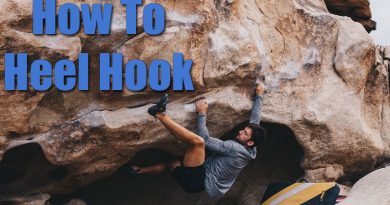When I first learned how to dropknee, it was a true revelation for me.
It especially helped me climb overhangs a lot smoother and with less waste of energy. Sadly, the dropknee is still an often underrated and underused technique. Today I’d like to share with you everything that I’ve learned about the climbing technique called the ‘Dropknee’ (or: ‘The Egyptian’), so that you can hopefully have your epiphany too!
So, what is the ‘dropknee’ exactly? It’s a footwork technique used in climbing and bouldering whereby you build tension between the two footholds on which your feet sit, by dropping down either of your knees inwardly, while turning the hip (that’s on the same side as the knee you’ve just dropped) towards the wall, to set yourself up for reaching the next hold.

When properly executed, the dropknee move builds enough tension between your feet to relieve the force put on your arms, so that you can reach for the next hold, which you’ll always do with the hand that’s on the same side as the dropped knee and inwardly turned hip.
There’s more things to consider when it comes to the drop knee, however. Knowing how to position your feet, how to deal with footholds that are positioned relatively high and knowing how to avoid injuries while doing the drop knee are all incredibly important to performing the dropknee safely and properly in the long run.
The reason why you want to add the dropknee to your climbing repetoir
Learning how to dropknee can propel you to the next level in your climbing. There are three main reason why you want to learn and master this technique.
- Extend your reach
The first and foremost reason you will want to employ the dropknee technique, is that it enables you to reach holds that are further away than you normally would be able to reach for. This is because you move one entire side of your body closer to the wall, by simultaneously getting your knee hip and shoulder close to the wall face. Naturally, this makes you larger because you minimize the angle between your hand, hips and feet.
- Improve your stability
Getting in a good dropkee will give you a very stable position to set up your next move. This is because of the tension you create, locking you in place.
- Save energy
By building outward tension between your feet, you’ll not only relief your arms from some weight; you’ll also be able to hang from extended arms for as long as possible until grabbing the next hold. Hanging from extended arms saves incredibly much energy compared to bent arms.
Risks of using the Dropknee
The dropknee is one of the most injury sensitive climbing techniques that you will deploy. Never use it if you havn’t warmed up properly. Some of the risks of injuries that are associated with the dropknee are:
- Strain on the knee. A minor stretching of one of the ligaments in your knee. This should heal after a couple of days.
- Injuries to the meniscus and knee ligaments, collectively known as the ‘Unhappy Triad’. These can knock you out for a longer period of time. You especially want to avoid problems with your meniscus.
- Dislocation of the knee. This can happen when a dropknee is followed up by a very dynamic move or when you lose your balance and fall awkwardly.
The dropknee move wouldn’t be used if you were guaranteed to get these kinds of injuries. It is certainly possible to avoid injuries altogether. It is, however, good to acknowledge the risks involved and to take the necessary precautionary measurements.
How to Dropknee: Step-by-step climbing guide
So let’s get into how precisely one executes the dropknee.
Below, I’ve written down all the steps which it involves.
I also found the video above incredebly helpful in explaining and especially showing it, so you might want to have a look at it first.
1. Starting position
The starting position of any dropknee is ideally having four points of contact, so with both hands and feet on holds.
2. Position your foot right
Make sure there’s enough space between your toes and the wall so that you can rotate your foot without getting stuck on the wall. The ideal point of contact may differ for each hold, but it should be somewhere near your big toe and the ball of your foot.
3. Rotate your foot
Rotate one of your feet in the direction of the centre of your body until it is pointing in a direction parallel to the wall.
4. Point your knee down and pull your hips in

Now bend your knee, ideally to a point that’s in a straight line between your two feet, wherever they are placed. You could sometimes even go lower, but be careful not to put too much strain on your ligaments.
In one smooth move, pull your hips closer towards the wall while turning your knee downward. The hip that’s on the side of your bent knee, should be close to the wall than your other hip.
5. Pull the opposite hand towards you for extra reach
In some cases, and to save as much energy as possible, you can skip this step. It all depends on the distance towards the next hold. Generally, at this point, you’ll want to start pulling the hand now that’s still left on its hold, so as to gain the momentum to grab the next hold.
If there’s one thing you should take away from this article, it’s this: Don’t start pulling before your knee is dropped. Keep your arms stretched until then!
6. Grab the next hold with the right hand
Lastly, reach out to the next hold and grab it. It’s as easy as that!
By now, you can finally place your hips in a position parallel to the wall’s face again. To save energy, it’s best not to linger in this position, though, and get to the next dropknee as soon as possible, reinstalling an angle between your hips and the wall.
Keep in mind that when doing the drop knee, your hips are not parallel to the wall any more. By twisting your hip, you allow the arm that’s holding unto a hold to stay stretched as long as possible, even while reaching for the next hold with your other arm. This saves a tremendous amount of energy in the long run.
Using the dropknee on high footholds
When a hold is really high, your elbow can actually get in the way of rotating your knee down. Moreover, you need to be a lot more flexibel to pull of a dropknee when the footholds are relatively high.
The risk of too high footholds is that you’re unable to lock in your knee properly. Without the right amount of tension, it can shoot off the foothold.
Always try to finish the entire move before reaching out to the next hold. If you can’t get a good dropknee in place, it may actually be better to make an exception and to play it safe: climbing to the next hold in a more inefficiënt manner.
Common dropknee mistakes
- Not committing. The result of not fully committing is that not enough pressure will be built up between your two legs, so that most of the positive effects of doing the dropknee are not fully effectuated. Go deeper to build up the pressure you need!
- Not twisting into the dropknee, and instead placing the foot in dropped position right from the outset. This makes the move unnecessarily hard. Sometimes, you’ll have to place your foot like this, but in most scenarios you can simply start the dropknee from a normal position with your hips parallel to the wall. Twist it from there.
- Reaching out with the wrong hand after the dropknee is in place. This results in an unstable position, that will pull you away from the wall.
Using the Dropknee technique at an overhang
When it comes to overhangs, it’s quite common, especially for beginners, to find yourself in a situation where you are dangling freely from your arms, without using your feet as points of contact.
I know I still do this sometimes..
Anyway, even beginning climbers quickly learn that we should try to keep our hips as close to the wall as possible.
With overhangs, this requires a lot of core strength, because you’re constantly battling gravity from pulling your behind away from the wall.
The great thing about the dropknee, is that it makes it a breeze to keep your hip close to the wall. Because of the tension you build up between your two feet, it requires way less core strength to press your hip to the face of the wall.
And it’s very possible to sustain this tension while you lunge for the next hold. You’ll find that it’ll become easier to not lose your footing all the time when climbing overhangs, once you master this technique.
Ultimately, employing the dropknee will help you minimize the amount of times you’re campussing your way up the wall, like a calisthenics enthusiast with no climbing experience would (I’ve met a few, and I know they would concur!). And you’ll be able to stick to the wall longer, even if you’re less strong!
The importance of warming up before using the dropknee
It’s important to properly warm up before attempting dropknees.
Warming up your joint capsule will reduce the risk of injuries to your meniscus.
As a warmup, I prefer to use the skipping rope and to do some squats. I also do some stretching. I only start doing dropknees when I feel that I’m fully warmed up, so as to not tear a muscle or ligament in my knee. We want to be able to climb consistently, after all!
Related questions
People that search for the dropknee technique, also often ask:
What is the twistlock technique?
The twistlock technique is closely related to the dropknee technique, and involves twisting the hip in an exaggerated fashion so close to the wall, that the body leans so heavily on the arm that is clinging onto a hold, that it locks the arm in place. It’s also akin to how the Figure Four Move locks the arm in place by placing the leg on top of the arm that’s latched onto a hold.
Why is the Dropknee also called the Egyptian?
The dropknee is also referred to as the ‘Egyptian’, because the silhouette ones body makes when performing the dropknee is reminiscent of the way the ancient egyptians depicted humans on murals: with bent knees, ankles, elbows and wrists.







